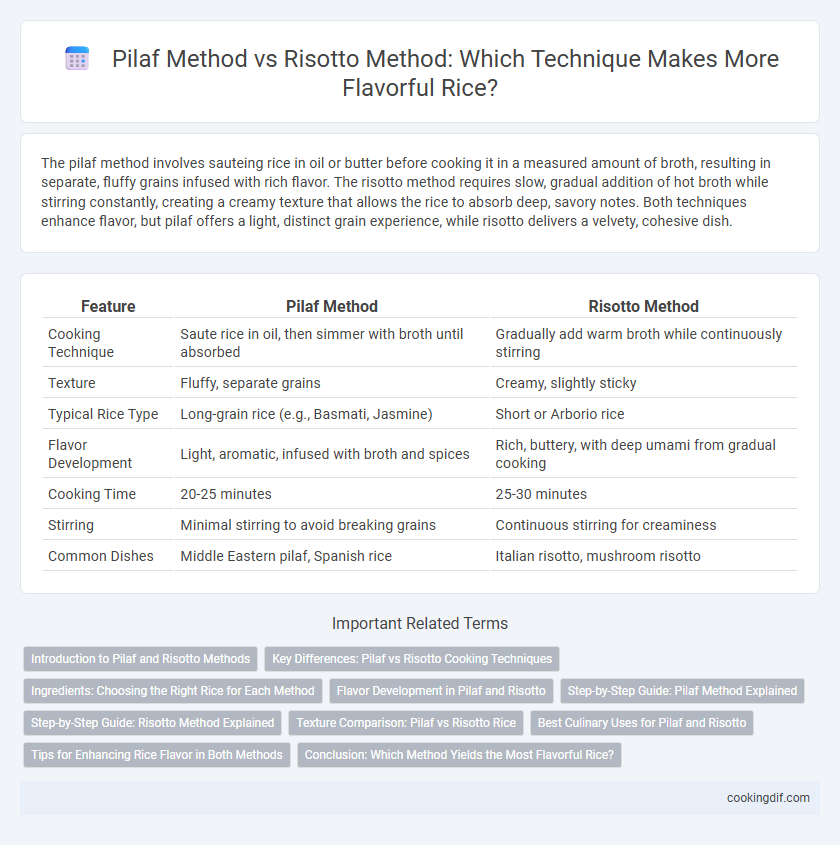The pilaf method involves sauteing rice in oil or butter before cooking it in a measured amount of broth, resulting in separate, fluffy grains infused with rich flavor. The risotto method requires slow, gradual addition of hot broth while stirring constantly, creating a creamy texture that allows the rice to absorb deep, savory notes. Both techniques enhance flavor, but pilaf offers a light, distinct grain experience, while risotto delivers a velvety, cohesive dish.
Table of Comparison
| Feature | Pilaf Method | Risotto Method |
|---|---|---|
| Cooking Technique | Saute rice in oil, then simmer with broth until absorbed | Gradually add warm broth while continuously stirring |
| Texture | Fluffy, separate grains | Creamy, slightly sticky |
| Typical Rice Type | Long-grain rice (e.g., Basmati, Jasmine) | Short or Arborio rice |
| Flavor Development | Light, aromatic, infused with broth and spices | Rich, buttery, with deep umami from gradual cooking |
| Cooking Time | 20-25 minutes | 25-30 minutes |
| Stirring | Minimal stirring to avoid breaking grains | Continuous stirring for creaminess |
| Common Dishes | Middle Eastern pilaf, Spanish rice | Italian risotto, mushroom risotto |
Introduction to Pilaf and Risotto Methods
The pilaf method involves sauteing rice in oil or butter before simmering it in seasoned broth, resulting in fluffy, separate grains infused with rich flavors. The risotto method uses constant stirring and gradual addition of broth to release starches, creating a creamy, cohesive texture with deep, savory taste. Both techniques highlight distinct approaches to layering flavor and texture in rice dishes using specific cooking sequences and liquid absorption strategies.
Key Differences: Pilaf vs Risotto Cooking Techniques
Pilaf cooking involves sauteing rice in oil or butter before simmering it in broth, resulting in separate, fluffy grains with infused flavors. Risotto requires slowly stirring arborio rice while gradually adding hot stock, creating a creamy texture due to the rice's high starch content. The pilaf method emphasizes firm, non-sticky rice, contrasting with risotto's rich, velvety consistency.
Ingredients: Choosing the Right Rice for Each Method
Long-grain rice such as basmati or jasmine is ideal for the pilaf method due to its ability to remain fluffy and separate after cooking, absorbing broth while maintaining texture. Arborio rice, with its high starch content, suits the risotto method as it releases creamy starch during slow cooking, creating a rich and smooth consistency. Selecting the appropriate rice variety enhances flavor absorption and texture, making each cooking technique distinct and effective.
Flavor Development in Pilaf and Risotto
The pilaf method enhances flavor by toasting rice grains in oil or butter before simmering, which creates a nutty, aromatic base through Maillard reactions. In contrast, the risotto method involves slowly adding broth while stirring, allowing gradual starch release that results in a creamy texture and rich, infused taste. Each technique uniquely develops flavor profiles, with pilaf emphasizing toasted, separated grains and risotto yielding a velvety, intensely savory dish.
Step-by-Step Guide: Pilaf Method Explained
The pilaf method involves sauteing rice in oil or butter until lightly toasted to develop a nutty aroma, followed by gradual absorption of hot broth which ensures each grain remains separate and fluffy. Unlike the risotto method that requires constant stirring to release starch for a creamy texture, pilaf cooking relies on a precise ratio of liquid to rice and minimal stirring to preserve distinct grains. This step-by-step approach starts with sweating aromatics, toasting rice, then simmering covered until perfectly tender with infused flavors.
Step-by-Step Guide: Risotto Method Explained
The risotto method involves toasting Arborio rice in butter or oil, then gradually adding warm broth while continuously stirring to release starches, resulting in a creamy texture. This method requires constant attention and patience to achieve perfectly cooked, flavorful rice with a rich, velvety consistency. Unlike the pilaf method, which uses sauteing and a single broth addition followed by simmering, risotto's step-by-step gradual liquid absorption enhances the depth of flavor and creaminess.
Texture Comparison: Pilaf vs Risotto Rice
Pilaf rice features separate, fluffy grains achieved by sauteing rice in oil before simmering in broth, resulting in a light, dry texture ideal for pairing with robust dishes. Risotto rice, typically arborio or carnaroli, creates a creamy, velvety consistency due to gradual liquid absorption and constant stirring, releasing starches that bind the dish. The pilaf method provides distinct grains with a tender bite, while risotto embraces a rich, cohesive texture perfect for hearty, saucy recipes.
Best Culinary Uses for Pilaf and Risotto
Pilaf method involves sauteing rice in oil or butter before simmering in broth, resulting in fluffy, separate grains ideal for Mediterranean, Middle Eastern, and Indian dishes such as biryani and pilafs with nuts and dried fruits. Risotto method uses constant stirring while gradually adding broth to release starch, creating a creamy, rich texture perfect for Italian dishes like mushroom risotto or seafood risotto. Pilaf excels in dishes requiring distinct grains and aromatic spices, while risotto suits recipes demanding a velvety, cohesive consistency rich in umami flavors.
Tips for Enhancing Rice Flavor in Both Methods
For robust flavor in pilaf, toast the rice grains in oil or butter before gradually adding warm broth, allowing the grains to absorb the liquid evenly. In risotto, slowly ladle hot stock into the rice while continuously stirring to release the starches, creating a creamy texture and deepening flavor. Incorporating aromatics like onions, garlic, fresh herbs, and finishing with Parmesan or butter enhances the richness and complexity in both cooking techniques.
Conclusion: Which Method Yields the Most Flavorful Rice?
Pilaf method produces fluffy, separate grains by sauteing rice and gradually adding broth, enhancing flavor through aromatic ingredients and controlled absorption. Risotto method yields creamy, rich rice by slowly stirring hot broth into arborio rice, releasing starches that create a velvety texture with intensified taste. For maximum flavor, risotto offers a more luxurious, deeply infused profile, while pilaf emphasizes distinct texture and subtly enhanced aroma.
Pilaf method vs risotto method for flavorful rice Infographic

 cookingdif.com
cookingdif.com